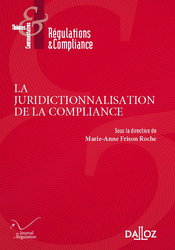MERABET, Samir🕴️
📝La vigilance, être juge et ne pas juger, in 🕴️M.-A. Frison-Roche (ed.), 📕La juridictionnalisation de la Compliance
pour lire cette présentation en français ↗️cliquer sur le drapeau français

► Full Reference: S. Merabet, "La vigilance, être juge et ne pas juger" ("Vigilance, to be a judge and not judging"), in M.-A. Frison-Roche (ed.), La juridictionnalisation de la Compliance, coll. "Régulations & Compliance", Journal of Regulation & Compliance (JoRC) and Dalloz, 2023, p. 199-209.
____
📕read a general presentation of the book, La juridictionnalisation de la Compliance, in which this article is published
____
► Summary of the article (done by the author): Vigilance presents two diametrically opposed dangers. The company is caught in the crossfire. On the one hand, there is a risk that it exercises its role at a minimum, so that the obligations imposed on it are ineffective, thereby risking its own liability. On the other hand, the danger is that the company oversteps its role and takes the place of the Judge. Does Vigilance always present the same dangers? Does it systematically involve the same role of the company? To be vigilant, is it to judge? The answer to these questions depends on the content of the obligations involved in Vigilance. However, these now seem very diverse.
How to distinguish between the various duties of Vigilance? A first approach could consist in considering a formal identification which leads to distinguish stricto sensu Vigilance, that which is envisaged by the French so-called "Sapin 2" law and identified as such, and the related obligations, such as for example the duty of moderation of companies on social networks, which without being baptized "duty of vigilance", nevertheless come close. The extension of Compliance obligations blurs the line between what exactly falls under Vigilance and what not. A more substantial approach should be taken to consider the degree of control exercised by the company. Understood in this way, it is possible to distinguish two categories: Negative Vigilance, which implies the identification of a risk, and Positive Vigilance, which even more supposes the neutralization of the risk. The first assumes a limited role for the company, while the second encourages it to act positively, even before an Authority has spoken. In this case, the role of the company is closer to that of the judge. That shows that all the obligations of vigilance cannot therefore be understood in a unitary manner.
As soon as the company is led - if not to take the place of the Judge - to act before the Judge even has the opportunity to pronounce himself/herself, then it seems legitimate to supervise the implementation of the company's duty of Vigilance, through a form of proceduralisation of Compliance. The company, as its employees or partners, would benefit from more Vigilance supervision. Insofar as all Vigilance obligations do not call the same role of the company, it is necessary to consider guiding principles of Vigilance, more or less intense depending on whether it is Negative or Positive Vigilance.
________
comments are disabled for this article